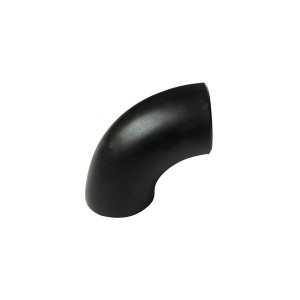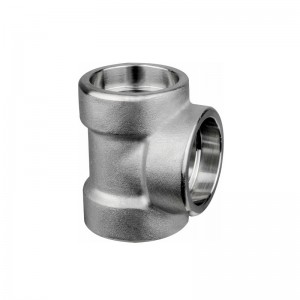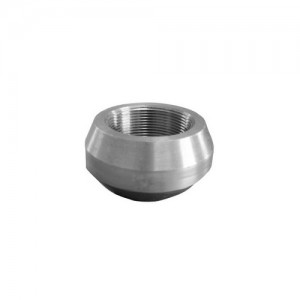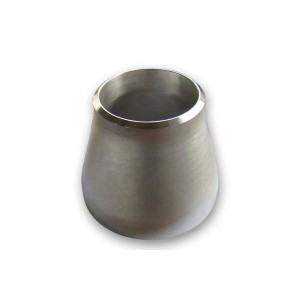Steel Butt Welding Pipe Fittings 90 Degree Elbow
90 Degree Elbow
Material: Carbon Steel, Stainless Steel, Alloy Steel
Technical: Forged and pushing
Connection: Welding
Standard: ANSI, ASME,AP15L,DIN,JIS,BS,GB
Type: 45°and 90°LR/SR Elbow, Reducers, Tee, Bends, Cap, Cross.
Wall Thickness: SCH5-SCH160 XS XXS STD
Surface: Black Paint/Rust-proof Oil/Hot Dipped Galvanized
Angles: 30/45/60/90/180°
Size: 1/2”-80”/DN15-DN2000
Certificate: ISO -9001:2000, API, CCS
Application: Chemical Industry, Petroleum Industry, Construction Industry and Other
Inspection: Factory In-House Check or The Third Party Inspection
Packing: Plywood Pallets/ Wooden Case Or As Per your Specification
Technological Process
Seamless elbow: an elbow is a fitting used at the turn of a pipe. Among all the pipe fittings used in the pipeline system, the proportion is the largest, about 80%. Generally, different forming processes are selected for elbows with different materials or wall thickness. The common forming processes of seamless elbow in manufacturers include hot pushing, stamping, extrusion, etc.
1. Hot push forming
The hot pushing elbow forming process is a process of heating, expanding and bending the blank sleeved on the die under the push of the pushing machine by using a special elbow pushing machine, core die and heating device. The deformation characteristic of the hot push elbow is to determine the billet diameter according to the law that the volume of the metal material remains unchanged before and after plastic deformation. The billet diameter used is less than the elbow diameter. The deformation process of the billet is controlled through the core die to make the compressed metal flow at the inner arc and compensate to other parts thinned due to diameter expansion, so as to obtain an elbow with uniform wall thickness.
The forming process of hot push elbow has the characteristics of beautiful appearance, uniform wall thickness and continuous operation, which is suitable for mass production. Therefore, it has become the main forming method of carbon steel and alloy steel elbow, and is also used in the forming of some specifications of stainless steel elbow.
The heating methods of the forming process include medium frequency or high frequency induction heating (the heating ring can be multi circle or single circle), flame heating and reverberatory furnace heating. The heating method depends on the requirements of the formed products and energy conditions.
2. Stamping forming
3. Medium plate welding
Use the medium plate to make half of the elbow section with a press, and then weld the two sections together. This process is generally used for elbows above DN700.
Other forming methods
In addition to the above three common forming processes, seamless elbow forming also adopts the forming process of extruding the tube blank to the outer die and then shaping through the ball in the tube blank. However, this process is relatively complex, troublesome to operate, and the forming quality is not as good as the above process, so it is rarely used
ASME B16.9, B16.28
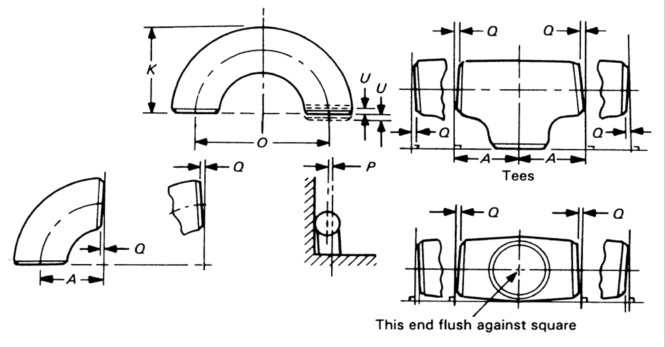
|
Pipe Size |
All Fittings |
90 & 45 Elbows and Tees |
Reducers and Lap Joint Stub ends |
Caps |
|||||||
|
|
Outside Diameter at Bevel, D (1) |
Inside Diameter at End (1) |
Wall Thickness t |
Center-to-End Dimensions A,B,C,M |
Overall Length, F,H |
|
|||||
|
|
|
|
|
|
|
Overall Length, E |
|||||
|
|
|
|
|
|
|
|
|||||
|
|
IN |
MM |
IN |
MM |
|
IN |
MM |
IN |
MM |
IN |
MM |
|
½ ~ 2½ |
+0.06 |
+1.6 |
±0.03 |
±0.8 |
Not Less Than 87.5% of Nominal Thickness |
±0.06 |
±2 |
±0.06 |
±2 |
±0.12 |
±3 |
|
|
-0.03 |
-0.8 |
|
|
|
|
|
|
|
|
|
|
3 ~ 2½ |
±0.06 |
±1.6 |
±0.06 |
±1.6 |
|
|
|
|
|
|
|
|
4 |
|
|
|
|
|
|
|
|
|
|
|
|
5 ~ 8 |
+0.09 |
+2.4 |
|
|
|
|
|
|
|
±0.25 |
±6 |
|
|
-0.06 |
-1.6 |
|
|
|
|
|
|
|
|
|
|
10 ~ 18 |
+0.16 |
+4.0 |
±0.12 |
±3.2 |
|
±0.09 |
|
±0.09 |
|
|
|
|
|
-0.12 |
-3.2 |
|
|
|
|
|
|
|
|
|
|
20 ~ 24 |
+0.25 -0.19 |
+6.4 -4.8 |
±0.19 |
±4.8 |
|
|
|
|
|
|
|
|
26 ~ 30 |
|
|
|
|
|
±0.12 |
±3 |
±0.19 |
±5 |
±0.38 |
±10 |
|
|
|
|
|
|
|
|
|
|
|
|
|
|
32 ~ 48 |
|
|
|
|
|
±0.19 |
±5 |
|
|
|
|
|
Pipe Size |
Lap Joint Stub Ends (2) |
180 Return Bends |
||||||||||
|
|
Outside Diameter of Lap, G |
Lap Thickness |
Fillet Radius of Lap, R |
Center-to-Center Dimension, O |
Back-to- Face Dimension, K |
Alignment of Ends, U |
||||||
|
|
|
|
|
|
|
|
||||||
|
|
|
|
|
|
|
|
||||||
|
|
IN |
MM |
IN |
MM |
IN |
MM |
IN |
MM |
IN |
MM |
IN |
MM |
|
½ ~ 2½ |
+0 -0.03 |
+0 -1 |
+0.06 -0 |
+1.6 -0 |
+0 -0.03 |
+0 -1 |
±0.25 |
±6 |
±0.25 |
±6 |
±0.03 |
±1 |
|
3 ~ 2½ |
|
|
|
|
|
|
|
|
|
|
|
|
|
4 |
|
|
|
|
+0 -0.06 |
+0 -2 |
|
|
|
|
|
|
|
5 ~ 8 |
|
|
|
|
|
|
|
|
|
|
|
|
|
10 ~ 18 |
+0 -0.06 |
+0 -2 |
+0.12 -0 |
+3.2 -0 |
|
|
±0.38 |
±10 |
|
|
±0.06 |
±2 |
|
20 ~ 24 |
|
|
|
|
|
|
|
|
|
|
|
|
|
Pipe Size |
Off Angle, Q |
Off Plane, P |
||
|
|
IN |
MM |
IN |
MM |
|
½ ~ 4 |
± 0.03 |
± 1 |
± 0.06 |
± 2 |
|
5 ~ 8 |
± 0.06 |
± 2 |
± 0.12 |
± 4 |
|
10 ~ 12 |
± 0.09 |
± 0.19 |
± 5 |
|
|
14 ~ 16 |
± 3 |
± 0.25 |
± 6 |
|
|
18 ~ 24 |
± 0.12 |
± 4 |
± 0.38 |
± 10 |
|
26 ~ 30 |
± 0.19 |
± 5 |
||
|
32 ~ 42 |
± 0.50 |
± 13 |
||
|
44 ~ 48 |
± 0.75 |
± 19 |
||
NOTES:
Out-of-round is the sum of absolute values of plus and minus tolerances.
Outside diameter of barrel see the table on page 15.






